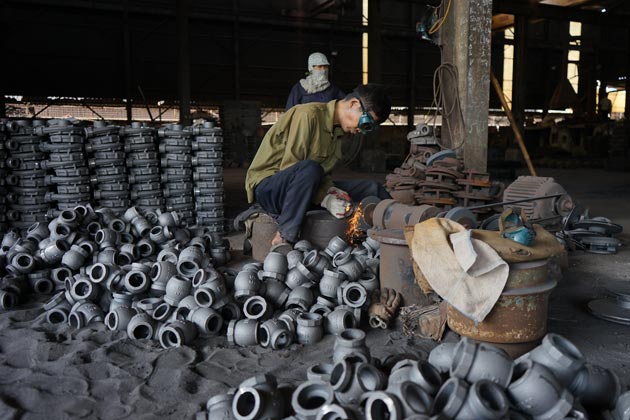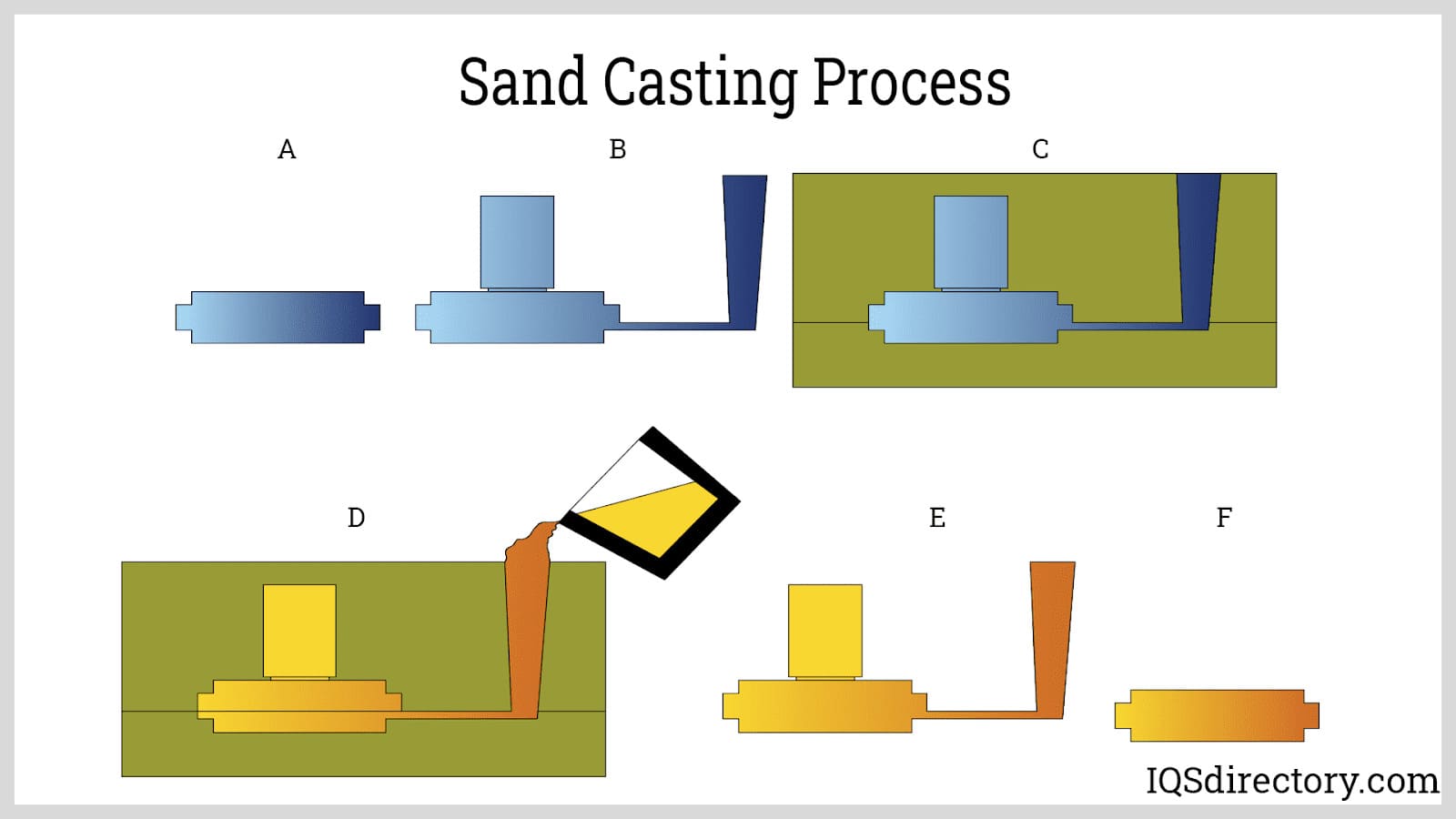Why Aluminum Foundry Wisconsin remains to be important in casting
Wiki Article
How Aluminum Foundry Adds To Advancements in Aerospace Design
Aluminum foundries are integral to improvements in aerospace engineering. They generate lightweight, high-strength parts that are essential for modern aircraft. Through sophisticated spreading techniques, these factories develop complex geometries that enhance structural integrity. Additionally, the development of exceptional Aluminum alloys supports the market's emphasis on gas efficiency and sustainability. However, difficulties stay in the manufacturing process. Comprehending these variables exposes the profound influence of Aluminum on aviation's future.The Importance of Lightweight Materials in Aerospace Style
As the aerospace market proceeds to develop, the relevance of light-weight products comes to be progressively obvious. The demand for effectiveness and sustainability drives engineers to focus on using materials that reduce general weight without jeopardizing structural honesty. Light-weight products, especially Aluminum, play a vital duty in boosting gas efficiency, improving haul ability, and raising the overall performance of airplane.The combination of these products enables for cutting-edge styles, enabling suppliers to produce more wind resistant forms that can stand up to severe conditions. The reduction in weight not only decreases operational prices yet likewise contributes to a reduced environmental impact, aligning with global initiatives towards sustainability in aeronautics.
Advanced Spreading Techniques in Aluminum Foundries
Advanced spreading methods in Aluminum foundries play an essential duty in aerospace engineering by allowing the manufacturing of accurate and light-weight elements. Technologies in mold and mildew design and accuracy spreading procedures are important in achieving excellent performance and structural stability. In addition, the development of light-weight alloys boosts the overall efficiency and effectiveness of aerospace applications.Cutting-edge Mold Style
Ingenious mold and mildew layout plays a necessary duty in the effectiveness and performance of Aluminum foundries, particularly within the aerospace sector. By leveraging innovative products and strategies, modern molds can be crafted to stand up to heats and stress, making sure peak efficiency during the spreading process. These styles frequently incorporate complex geometries that enable the production of light-weight yet structurally audio components, important for aerospace applications. Additionally, the usage of computer-aided style (CAD) software application helps with exact modeling, making it possible for shops to fine-tune and mimic mold and mildew styles before physical production begins. This not only improves the high quality of actors parts yet additionally lowers waste and preparation, bring about significant expense savings. Generally, innovative mold style is a cornerstone of progression in Aluminum Foundry modern technology for aerospace engineering.Precision Casting Processes
The performance of innovative mold and mildew designs effortlessly integrates with precision spreading processes, which are essential for generating top quality Aluminum parts in aerospace design. These processes, consisting of sand spreading, pass away spreading, and financial investment casting, guarantee the creation of complex geometries with limited tolerances. Advanced methods like vacuum casting and pressure pass away casting improve the honesty and surface area finish of the final products. Accuracy spreading minimizes material waste while making best use of the mechanical properties of Aluminum, essential for aerospace applications. Furthermore, utilizing real-time monitoring and advanced simulation tools throughout the spreading procedure permits instant changes, leading to enhanced quality assurance. Jointly, these precision spreading procedures setting Aluminum shops at the forefront of aerospace innovation, sustaining the sector's need for reliability and performance.Lightweight Alloy Development
As aerospace engineers look for to enhance gas efficiency and efficiency, light-weight alloy advancement ends up being a crucial focus in Aluminum foundries. These factories employ sophisticated casting methods to create alloys that give superior strength-to-weight ratios. Technologies in alloy structure, consisting of the consolidation of components like lithium and magnesium, allow the production of materials that endure severe problems while minimizing general aircraft weight. Strategies such as die casting and financial investment casting assist in the precision manufacturing of intricate forms, which are essential for aerospace applications. Additionally, continuous research aims to enhance these alloys for improved mechanical homes and increased toughness. By focusing on light-weight alloy development, Aluminum shops considerably add to the advancement of aerospace engineering, paving the means for more lasting and reliable airplane layouts.
Enhancing Structural Integrity With Aluminum Parts
Aluminum components offer considerable benefits in improving architectural honesty within aerospace engineering. Their light-weight nature adds to overall performance while keeping toughness, which is vital for aircraft performance. Furthermore, the stress resistance homes of Aluminum help assure the durability and dependability of aerospace structures under different operational problems.
Light-weight Product Perks
While conventional materials usually jeopardize weight for toughness, making use of Aluminum components in aerospace design uses considerable advantages in structural integrity. Aluminum's light-weight nature adds to general style performance, enabling for even more structured airplane that consume less fuel, thus improving sustainability. The product's excellent strength-to-weight proportion assurances that elements keep durability without adding unnecessary mass. This high quality cultivates improved efficiency and dexterity in flight, as well as optimized payload capabilities. Furthermore, Aluminum's resistance to corrosion prolongs the life-span of aerospace structures, minimizing upkeep costs and improving security. As suppliers progressively take on Aluminum alloys, the aerospace market experiences a transformative change in the direction of much more effective and reliable engineering options that focus on both efficiency and ecological duty.Stress And Anxiety Resistance Characteristics
Although various products have special residential properties, Aluminum's phenomenal tension resistance sticks out as an essential element in boosting the architectural integrity of aerospace parts. This resistance plays a critical duty in making certain that airplane can stand up to different functional stresses, consisting of fatigue, influence, and environmental conditions. Aluminum alloys, specifically engineered for aerospace applications, exhibit high tensile strength while maintaining lightweight attributes, making it possible for designers to create extra reliable structures - Aluminum Foundry. Additionally, the capability of Aluminum to withstand cyclic loading without significant deformation adds to the long life and integrity of aerospace elements. As advancements continue in Aluminum Foundry methods, the development of stress-resistant Aluminum parts assures more renovations in performance, security, and efficiency throughout the aerospace industry, solidifying Aluminum's duty as a favored material in contemporary engineeringFuel Performance Improvements Driven by Aluminum Innovations
As the aerospace market seeks to enhance gas effectiveness, ingenious usages of Aluminum have actually arised as an important solution. Aluminum's lightweight nature especially lowers airplane weight, permitting for lower gas consumption during trip. This decrease in weight is crucial, as even small decreases can bring about considerable enhancements in general gas economic situation.Advanced Aluminum alloys, designed for improved toughness and longevity, allow manufacturers to produce elements that keep structural integrity while lessening mass - Aluminum Foundry. Furthermore, the assimilation of Aluminum in airframes and engine parts assists in boosted aerodynamics, adding to minimized drag and enhanced efficiency
The adoption of Aluminum in aerospace not just fulfills the need for fuel-efficient style however likewise straightens with regulatory pressures for lower emissions. As these technologies remain to evolve, they play a significant role in setting new standards for gas effectiveness, making sure that the aerospace industry can satisfy expanding economic and ecological challenges.

The Role of Aluminum in Sustainable Aeronautics Practices
The raising emphasis on sustainable air travel techniques has placed Aluminum as a vital product in see this page the mission for greener airplane design. Known for its light-weight residential properties, Aluminum considerably decreases aircraft weight, bring about lower gas consumption and discharges. Its recyclability further enhances its sustainability profile, as Aluminum can be recycled forever without loss of top quality. This characteristic here sustains a circular economic situation within the air travel sector, minimizing waste and source deficiency.In addition, improvements in Aluminum alloys have actually boosted their strength and rust resistance, permitting longer service life and lowered maintenance demands. These technologies help with the development of extra reliable aircraft frameworks, adding to general sustainability initiatives. In addition, Aluminum's thermal conductivity plays an important role in energy-efficient layouts, enhancing systems such as warmth exchangers. Collectively, these features emphasize Aluminum's crucial role beforehand lasting aeronautics, aligning with international initiatives aimed at reducing the ecological impact of flight.
Obstacles Dealt With by Aluminum Foundries in Aerospace Production
While Aluminum shops play a crucial function in aerospace production, they face considerable obstacles that can impact manufacturing performance and high quality. One significant challenge is the rigorous quality control requirements called for in the aerospace sector. Any flaw can endanger safety and performance, requiring rigorous examination processes that expand production timelines. Furthermore, foundries often compete with varying basic material prices, which can affect rates and earnings. The intricacy of Aluminum alloys utilized in aerospace applications more makes complex the manufacturing procedure, as exact formulations are vital for attaining wanted mechanical homes. Proficient labor shortages hinder the capacity to preserve top notch production degrees. Finally, environmental laws impose restrictions on emissions and waste management, requiring shops to buy lasting methods, which can be cost-prohibitive. These variables collectively develop a landscape where Aluminum shops must continuously adapt to satisfy the evolving demands of aerospace production while making certain security and compliance.Future Fads in Aluminum Applications for Aerospace Engineering
With developments in technology and raising needs for efficiency, the future of Aluminum applications in aerospace engineering is positioned for significant improvement. The integration of cutting-edge Aluminum alloys and composites is anticipated to improve strength-to-weight ratios, resulting in more fuel-efficient airplane layouts. On top of that, improvements in additive manufacturing methods will permit the manufacturing of complex Aluminum frameworks that were formerly difficult, enhancing performance and lowering waste.
Lasting methods will play a crucial duty, with a growing focus on recycling Aluminum to decrease ecological impact. The aerospace industry is likely to accept smarter producing procedures, such as automation and expert system, making sure better and precision in Aluminum parts. Cooperations between Aluminum factories and aerospace firms will foster study and advancement, paving the method for brand-new applications that fulfill the strict demands of contemporary aerospace engineering. Generally, the future looks assuring for Aluminum's role in shaping the skies
Often Asked Concerns
What Are the Ecological Impacts of Aluminum Manufacturing in Aerospace?
The environmental influences of Aluminum manufacturing in aerospace consist of substantial energy consumption, greenhouse gas discharges, and habitat disturbance. In addition, mining processes can bring about dirt deterioration and water contamination, raising issues about sustainability and ecological equilibrium.Just How Does Aluminum Contrast to Various Other Materials in Aerospace Applications?
Aluminum offers an one-of-a-kind mix of lightweight properties, deterioration resistance, and cost-effectiveness contrasted to various other materials. Its high strength-to-weight proportion makes it particularly helpful for aerospace applications, boosting fuel efficiency and overall performance in aircraft style.What Credentials Do Aluminum Foundry Workers Requirement for Aerospace Projects?
Aluminum Foundry workers need customized training in metallurgy and casting strategies, along with understanding of aerospace industry criteria. Accreditations in quality assurance and security methods are likewise vital to assure compliance with rigid aerospace project demands.Exist Any Safety And Security Worry About Making Use Of Aluminum in Aerospace Engineering?
Safety and security issues relating to Aluminum in aerospace engineering consist of sensitivity to deterioration, stress, and tiredness fractures. Appropriate treatment and alloy choice are necessary to alleviate these dangers, guaranteeing structural stability and general safety in aerospace applications.Just How Does Aluminum Recycling Advantage the Aerospace Market?
Aluminum recycling substantially benefits the index aerospace industry by lowering material expenses, minimizing environmental impact, and saving energy. This sustainable practice boosts the sector's effectiveness while promoting using light-weight, high-performance parts in airplane production.Advanced casting strategies in Aluminum foundries play an essential function in aerospace engineering by allowing the manufacturing of specific and light-weight elements. Cutting-edge mold style plays a necessary function in the efficiency and effectiveness of Aluminum foundries, especially within the aerospace market. As aerospace designers seek to improve gas effectiveness and performance, light-weight alloy growth ends up being an important emphasis in Aluminum factories. Aluminum alloys, specifically crafted for aerospace applications, exhibit high tensile toughness while keeping lightweight attributes, making it possible for designers to make extra reliable structures. Cooperations in between Aluminum foundries and aerospace companies will certainly foster study and development, paving the method for brand-new applications that satisfy the rigid requirements of modern aerospace design.
Report this wiki page